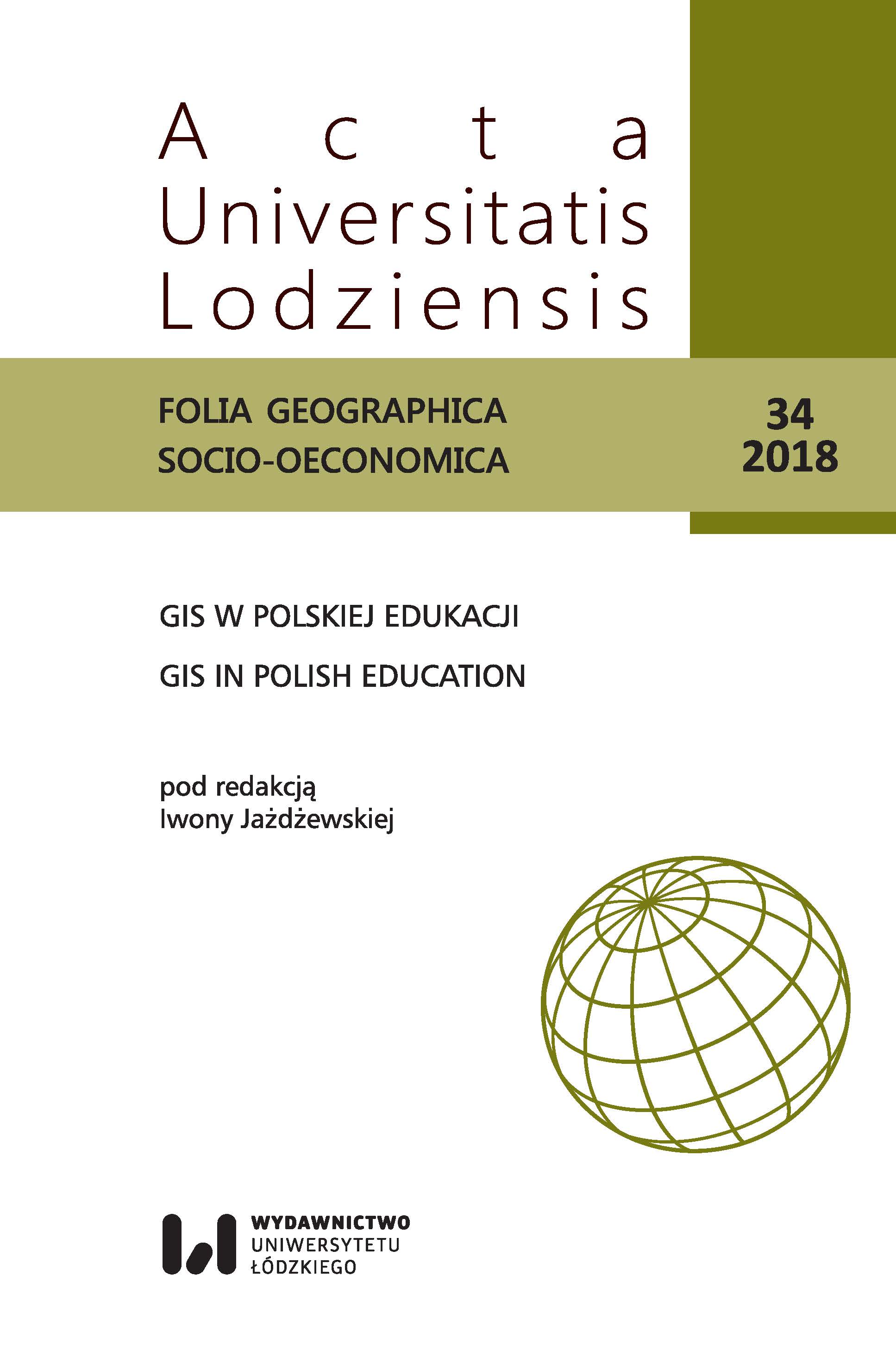Application of Geographic Information Systems (GIS) in geographic didactics. Example of terrain exercises ”Geography of Tourism and Hotel Industry”
DOI:
https://doi.org/10.18778/1508-1117.34.05Keywords:
tourism and recreation, GIS, tourist function, tourist attractiveness, land use map, point valuationAbstract
The aim of the article is to present the methodology of study of the tourism function on the example of the Spała village with the use of Geographic Information Systems (GIS) and the possibility of using them for didactic purposes in the field of Tourism and Recreation on the example of field exercises ”geography of tourism and hotel industry”. The spatial range of field studies conducted as part of the exercises included the Spała village. During the exercise, two spatial methods for determining tourist function were used: land use map and point valuation. Exercises were carried out using GIS technology and tools, including ArcGIS 10.4 (desktop) and ArcGIS Online. The obtained results indicate that the tourist function of the Spała village is well developed. Areas that perform tourist and recreational functions constitute a significant percentage (over 10%) of plots and area (over 4%) of the studied area. However, the most attractive in terms of tourism are the areas located in Spała, in the center of the village, on the Pilica and Gać rivers and along the main communication and tourist routes. The great advantage of the presented methodology was the use of modern technological solutions and tools of Geographic Information Systems, including work in the cloud and with mobile devices. This allowed for:
– gathering a large amount of spatial data in a short time;
– developing students' skills of cooperation and teamwork;
– constant supervision of the progress of field work and the correctness of the data obtained, which prompted students to work more regularly and conscientiously;
– availability of research results and the possibility of discussing them directly during field exercises.
References
Anselin L., Getis A., 1992, Spatial statistical analysis and geographic information systems, „The Annals of Regional Science”, 26 (1): 19–33.
Google Scholar
Bielecka E., 2006, Systemy informacji geograficznej. Teoria i zastosowania, Wydawnictwo Polsko-Japońskiej Wyższej Szkoły Technik Komputerowych, Warszawa.
Google Scholar
ESRI, 2018, Czym jest usługa ArcGIS Online?, https://doc.arcgis.com/pl/arcgis-online/reference/what-is-agol.htm (dostęp: 27.12.2018).
Google Scholar
Gaździcki J., 2003, Leksykon geomatyczny, Polskie Towarzystwo Informacji Przestrzennej.
Google Scholar
Jażdżewska I., Lechowski Ł., 2018, Wstęp do geoinformacji z ArcGIS, Wydawnictwo Uniwersytetu Łódzkiego, Łódź.
Google Scholar
Jenness J., 2012, Repeating shapes for ArcGIS. Jenness Enterprises, http://www.jennessent.com/arcgis/repeat_shapes.htm (dostęp: 10.11.2018).
Google Scholar
Kaczmarek J., Stasiak A., Włodarczyk B., 2005, Produkt turystyczny, Wydawnictwo Naukowe PWN, Warszawa.
Google Scholar
Kowalczyk A., 2000, Geografia turyzmu, Wydawnictwo Naukowe PWN, Warszawa.
Google Scholar
Kurek W. (red.), 2007, Turystyka, Wydawnictwo Naukowe PWN, Warszawa.
Google Scholar
Latosińska J., Muszyńska A., 2013, Stare i nowe formy turystyki w przestrzeni – Spalski Jarmark Antyków i Rękodzieła Ludowego w świetle badań ruchu turystycznego, Warsztaty z Geografii Turyzmu: Nowe – stare formy turystyki w przestrzeni, 3, Wydawnictwo Uniwersytetu Łódzkiego, Łódź: 137–157.
Google Scholar
Latosińska J., Żek M., 2011, Funkcja turystyczna Spały, Warsztaty z Geografii Turyzmu: Turystyka polska w latach 1989–2009, Wydawnictwo Uniwersytetu Łódzkiego, Łodź: 93–115.
Google Scholar
Lemańczyk K., 2009, Typy Geobaz w ArcGIS, http//www.npgc.pl/index.php/2009/05/typy–geobaz–w–arcgis/ (dostęp: 26.09.2017).
Google Scholar
Liszewski S., 1978, Tereny miejskie. Podział i klasyfikacja, „Acta Universitatis Lodziensis”, Zeszyty Naukowe Uniwersytetu Łódzkiego, Nauki Matematyczno-Przyrodnicze, seria II (15): 3–33.
Google Scholar
Liszewski S., 1991, Spała. Morfologia i funkcja miejscowości wypoczynkowej, „Turyzm”, 2: 5–32.
Google Scholar
Litwin L., Myrda G., 2005, Systemy Informacji Geograficznej. Zarządzanie danymi przestrzennymi w GIS, SIP, SIT, LIS, Wydawnictwo HELION, Gliwice.
Google Scholar
Longley P., Goodchild M., Maguire D., Rhin D., 2006, GIS. Teoria i praktyka. Przekład pod redakcją naukową A. Magnuszewskiego, Wydawnictwo Naukowe PWN, Warszawa.
Google Scholar
MacDonald A., 2001, Building a geodatabase, ESRI Redlands.
Google Scholar
Tomlinson R.F., 2007, Rozważania o GIS: planowanie Systemów Informacji Geograficznej dla menedżerów, ESRI Polska.
Google Scholar
Uniwersytet Łódzki, 2018, Turystyka i Rekreacja – Studia II stopnia. Opis Studiów, http://informatory.uni.lodz.pl/wydzial-nauk-geograficznych/turystyka-i-rekreacja-3/ (dostęp: 22.11.2018).
Google Scholar
Warszyńska J., Jackowski A., 1979, Podstawy geografii turyzmu, Państwowe Wydawnictwo Naukowe, Warszawa.
Google Scholar
Rozporządzenie Ministra Infrastruktury z dnia 26 sierpnia 2003 roku w sprawie wymaganego zakresu projektu miejscowego planu zagospodarowania przestrzennego (Dz.U., 2003, nr 164, poz. 1587).
Google Scholar
Downloads
Published
How to Cite
Issue
Section
License

This work is licensed under a Creative Commons Attribution-NonCommercial-NoDerivatives 4.0 International License.








